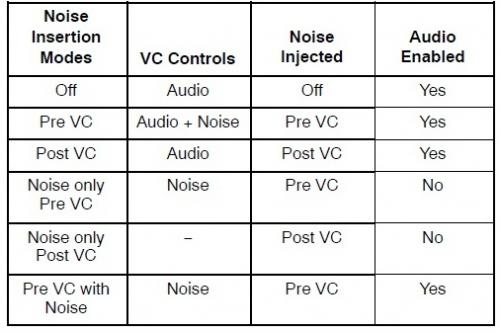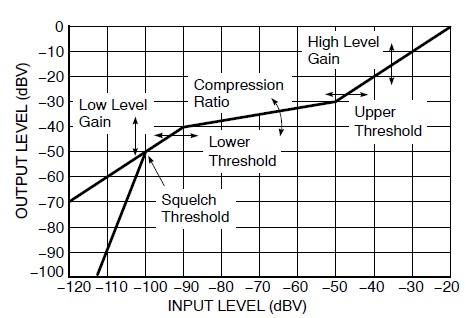Rhythm R3710预配置DSP系统实践应用指南
a very low power mode by selecting the Tinnitus Treatment noise only. This is beneficial either when amplification is not needed at all by a user or if the user would benefit from having the noise supplied to them during times when they do not need acoustic cues but their sub−conscious is still active, such as when they are asleep.
The ARK software has a Tinnitus Treatment tool that can be used to explore the noise shaping options of this feature. This tool can also be easily incorporated into another software application.
If the noise is injected before the VC and the audio path is also enabled, the device can be set up to either have both the audio path and noise adjust via the VC or to have the noise only adjust via the VC. If the noise in injected after the VC, it is not affected by VC changes (see Table 4).

Table 4. NOISE INJECTION EFFECT ON VC
Narrow−band Tone and Noise Stimulus
Rhythm R3710 is capable of producing Narrow−band Noise and Tone Stimuli that can be used for in situ audiometry. Each narrow−band noise is centred on an audiometric frequency. The duration of the stimuli is adjustable and the level of the stimuli are individually adjustable.
A/D and D/A Converters
The system’s A/D converter is a second order sigma−delta modulator operating at a 2.048 MHz sample rate. The system’s audio input is pre−conditioned with antialias filtering and a programmable gain pre−amplifier. This analog output is over−sampled and modulated to produce a 1−bit Pulse Density Modulated (PDM) data stream. The digital PDM data is then decimated down to Pulse−Code Modulated (PCM) digital words at the system sampling rate of 32 kHz.
The D/A is comprised of a digital, third order sigma−delta modulator and an H−bridge. The modulator accepts PCM audio data from the DSP path and converts it into a 64−times or 128−times over−sampled, 1−bit PDM data stream, which is then supplied to the H−bridge. The H−bridge is a specialized CMOS output driver used to convert the 1−bit data stream into a low−impedance, differential output voltage waveform suitable for driving zero−biased hearing aid receivers.
HRX Head Room Expander
Rhythm R3710 has an enhanced Head Room Extension (HRX) circuit that increases the input dynamic range of Rhythm R3710 without any audible artifacts. This is accomplished by dynamically adjusting the pre−amplifier’s gain and the post−A/D attenuation depending on the input Level.
Channel Processing
Figure 6 represents the I/O characteristic of independent
AGC channel processing. The I/O curve can be divided into
the following main regions:
Low input level expansion (squelch) region Low input level linear region Compression region High input level linear region (return to linear)

Figure 6. Independent Channel I/O Curve Flexibility
The I/O characteristic of the channel processing can be
adjusted in the following ways:
Squelch threshold (SQUELCHTH) Low level gain (LLGAIN) Lower threshold (LTH) High level gain (HLGAIN) Upper threshold (UTH) Compression ratio (CR)To ensure that the I/O characteristics are continuous, it is necessary to limit adjustment to a maximum of four of the last five parameters. During Parameter Map creation, it is necessary to select four parameters as user adjustable, or fixed, and to allow one parameter to be calculated.
The squelch region within each channel implements a low level noise reduction scheme (1:2 or
- Rhythm R3710预配置DSP混合系统重点详析(07-14)
- Rhythm R3710预配置DSP系统设计所需规范详析(07-14)
